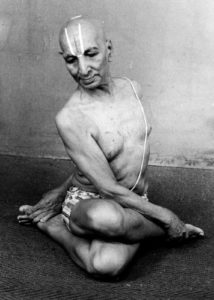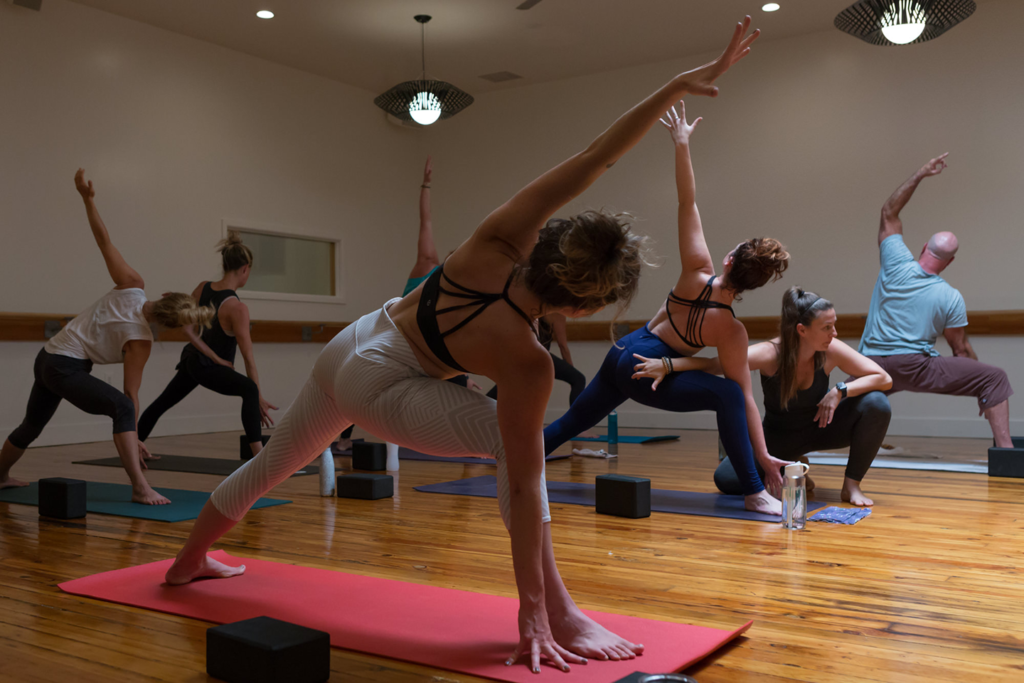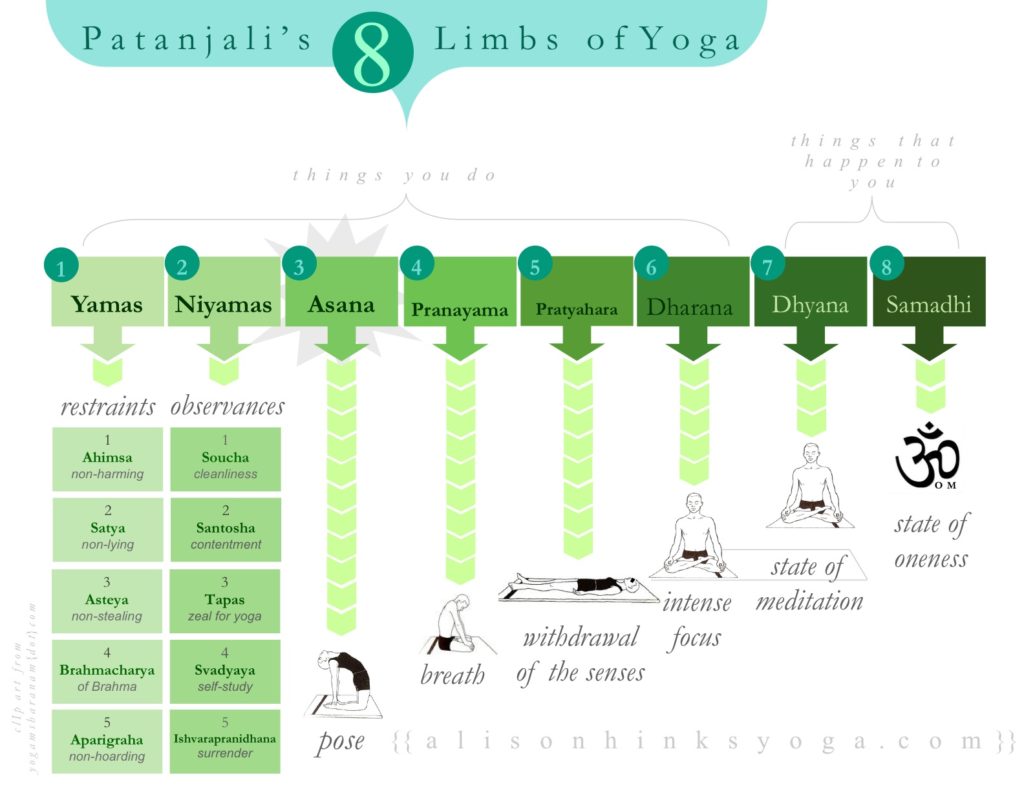The understanding of yoga has evolved in many directions since its origin, thousands of years ago, making the history of yoga fascinating to examine.
Today, our collective understanding of yoga is based on the fact that we find a studio on nearly every block. It’s based on the love of yoga wear and gear, which often has nothing to do with the physical practice itself. Perhaps more than anything, it’s based on the fact that the culture of modern yoga has taken a strong turn toward social media.
All of these facets just indicate how far modern yoga has ventured into a completely different direction, compared to its true north. It’s not that modern yoga is “right” or “wrong” — but without a doubt, it is different from the way it was historically intended.
When we talk about yoga in the West, what we’re really talking about is asana, or physical postures.
But to experts in the East, asana is only a fraction of the full experience of “yoga.”
To them, yoga is far more than just physical practice. It’s a wholesome way of life. Actually, yoga is life — a comprehensive ideology that offers teachings on how to live fully.
While physical postures are much less relevant in the larger scope of yoga, they are still a necessary piece of the yoga puzzle. These postures address the health of our physical body, our vehicle…. Which must be smooth-operating if we want to access the other aspects of human experience (mental, emotional, spiritual).
In this post we explore a glimpse at the history of yoga, with a particular focus on the physical practices of yoga. As yoga practitioners, it can be fulfilling to understand the roots of the practice; the origins of the “yoga” concept; and how it’s all so much grander than we could have possibly imagined.
Since yoga does have such an extensive history — we can break it down into eras to see more clearly the phases of yoga evolution.
History of Yoga: The Pre-Classical Era of Yoga
Yoga as a very large ideology is considered to be founded 5,000 (but probably more) years ago in Northern India by the Indus-Sarasvati civilization. The first time in the history of yoga that we see the actual word “yoga” is in the Vedas — a body of knowledge that is essentially considered the foundation of Hindu and Sanskrit literature.

Veda, in Sanskrit, translates to knowledge. Knowledge of life. There are four Vedas making up this collection of sacred texts. And the world “yoga” appears first in the Rig Veda. The Rig Veda gives the first known definition of yoga.
Yoga means “to yoke,” referring to the yoke which hitches an animal to a plow or cart, like a harness or collar. In this sense, we arrive at a primary definition of yoga — to join.
We could refer to this time as the Vedic era, taking place around 3300-1500 BCE. The philosophy of yoga at this time was in the hands of the Brahmans and Rishis (sacred sages), but “yoga” was still incredibly vague. It could have meant anything from God to breath technique.
A more refined understanding of yoga appears in later sacred texts, known as the Upanishads and Bhagavad-Gîtâ, around 500 BCE.
The Classical Era of Yoga
The shift into the classical era of yoga derives from the creation of the Yoga Sutras, by Patanjali — a brilliant Hindu sage. This time is estimated to be around 200 CE.
Prior to the Yoga Sutras, yoga was the receptacle of many different ideas and techniques. Patanjali essentially organized the philosophy through his Yoga Sutras. Sutras are like lessons, and Patanjali composed 196 of them.
Patanjali presented classical yoga in the structure of an Eight Limbed Path. Practicing all components of this path simultaneously is intended to be the path toward enlightenment.
We tend to hear components of the Eight Limbed Path in our yoga asana practice, depending on the teacher. The yamas and niyamas, for example, are commonly woven into class — this all originated from Patanjali.
The Post Classical Era of Yoga
The next iteration in the history of yoga begins a few centuries after Patanjali and the Yoga Sutras. Up to this era, we see yoga as a method to transcend reality.
With this era, yoga emerges as more of a life practice — as a means to deal with reality and the physicality of this human experience. Notably, this is also the era when yoga begins to travel around the world through certain acclaimed teachers (the early 1800’s). Yoga does not reach the U.S. until 1890’s.
The Modern Era of Yoga
In 1785, the Bhagavad Gita was translated to English by Charles Wilkins, thus initiating a global interest in yoga. Throughout this era, we see the concepts and philosophies of yoga travel internationally through a couple key figures.
Swami Vivekananda, a Hindu monk, is known as the individual who brought yoga and Vedanta (knowledge of the Vedas) to the Western half of the world. Swami Vivekananda reached America in 1893, bringing the East to the West through lectures on the Hindu philosophy. The knowledge that Swami Vivekananda spread did not address asana (physical postures) all all, and instead focused on the practices of pranayama (breathwork), meditation, and transcendental thinking.

T. Krishnamacharya, though he never visited the West himself, had a major influence on modern yoga — and the way we understand it as a physical practice. He was responsible for the surge of Hatha yoga around 1920, both in the West and the East. T. Krishnamacharya established the first Hatha yoga school in Mysore in 1924. He educated some of the teachers who continued to popularize Hatha Yoga in the West, including: BKS Iyengar, Pattabhi Jois, TVS Desikachar (son of Pattabhi Jois), and Indra Devi (his first female student).
Compared to his yogi predecessors, Krishnamacharya was innovative in developing an asana practice that responded to the “needs of the time.” He actually developed his yoga style in Tibet, ultimately creating something that blended Hatha yoga, British military training exercises, and southwest Indian gymnastics/wrestling.
His innovations led to a dynamic asana practice now understood as Ashtanga Yoga. His teachings have been extremely influential also in the creation of Vinyasa and Power Yoga.
The popularity of yoga in the West continued to grow. In 1947, Indra Devi opened her own yoga studio in Hollywood, which initiated the rapid growth of yoga, Western style. Western teachers have since adapted Hatha Yoga into their own styles. For example:
- Bikram Hot Yoga: Created by Bikram Choudhury in the 1970’s
- Jivamukti Yoga: Created by David Life and Sharon Gannon in 1984
- Forrest Yoga: Created by Ana Forrest in 1982
- Power Vinyasa Yoga: Popularized by Baron Baptiste in the 1990’s
- Anusara Yoga: Created by John Friend in 1992
Summarizing the History of Yoga
This is a bird’s eye view on the history of yoga, oriented toward the physical side of the practice. And while this is merely a summary, it gives us the most important take-away, which is that yoga is much more layered and ancient than we could have imagined.
What started as a vague yet powerful philosophy turned into a physical practice through the shaping of various individuals. And through this shaping, we have found ourselves with a practice that has turned out to achieve massive popularity in our modern culture.
The style of yoga that we offer at Ohana Yoga + Barre is known as Vinyasa. And Vinyasa happens to be one of the most popular styles of modern postural yoga. This free-flowing and breathy format also finds its roots in ancient yoga, but is a branch that looks much different than the others.
Understanding Vinyasa Yoga
In Sanskrit, yasa means “to place” and vi means “in a special way.” We can understand vinyasa as “to place in a special way.” In class you will also hear Vinyasa defined as “one breath, one movement,” or “movement linked with breath.”

Vinyasa is essentially an offshoot of Ashtanga Yoga. Vinyasa is almost a free-form Ashtanga. While Ashtanga has a set sequence of postures, which must be mastered and completed in a specific order, Vinyasa is fluid and free. Often a Vinyasa class will cover many of the poses in the Ashtanga series, but the order of the postures and approach can be completely different.
The one element that will be emphasized in every Vinyasa class everywhere, is breath. Whereas Ashtanga is taught with the perspective of “get into the pose, then work on the breath,” Vinyasa is taught with the perspective of “get into the next pose with the breath.”
Instead of a set series, Vinyasa yoga is built upon creativity and intelligent sequencing, paired with breathwork. Because of the breath-posture relationship in Vinyasa, smooth transitions are also a trademark of this practice. At this point, it’s not challenging to see why Vinyasa is often described with the word flow.
At Ohana, all of our classes are Vinyasa, though our teachers have their own certain styles. If you have any questions about our classes, or the content in this article, please comment below! You can book your next Vinyasa yoga class here.
